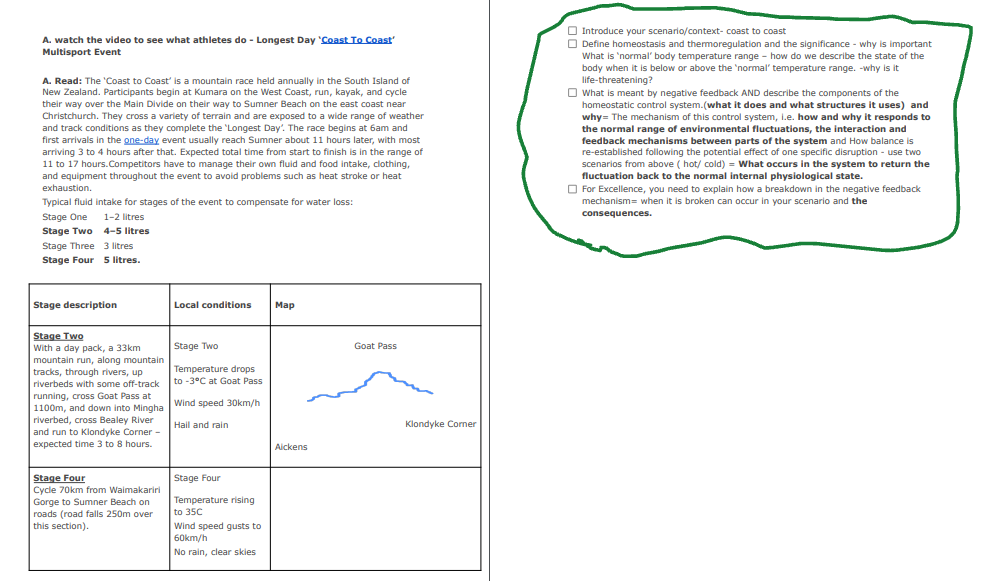O Introduce your scenario/context- coast to coast O Define homeostasis and thermoregulation and the significance - why is important What is 'normal body temperature range - how do we describe the state of the body when it is below or above the 'normal temperature range. -why is it life-threatening? OWhat is meant by negative feedback AND describe the components of the homeostatic control system.(what it does and what structures it uses) and why= The mechanism of this control system, Le. how and why it responds to the normal range of environmental fluctuations, the interaction and feedback mechanisms between parts of the system and How balance is re-established following the potential effect of one specific disruption - use two scenarios from above ( hot/ cold) = What occurs in the system to return the fluctuation back to the normal internal physiological state.
O Introduce your scenario/context- coast to coast O Define homeostasis and thermoregulation and the significance - why is important What is 'normal body temperature range - how do we describe the state of the body when it is below or above the 'normal temperature range. -why is it life-threatening? OWhat is meant by negative feedback AND describe the components of the homeostatic control system.(what it does and what structures it uses) and why= The mechanism of this control system, Le. how and why it responds to the normal range of environmental fluctuations, the interaction and feedback mechanisms between parts of the system and How balance is re-established following the potential effect of one specific disruption - use two scenarios from above ( hot/ cold) = What occurs in the system to return the fluctuation back to the normal internal physiological state.
Chapter1: Word Building Rules
Section: Chapter Questions
Problem B1CRE
Related questions
Question
100%
"Since we only answer up to 3 sub-parts, we’ll answer the first 3. Please resubmit the question and specify the other subparts (up to 3) you’d like answered."
as you said you will answer anohher 3 subpart in another qouestion please please do so, as i already subscribe it
also i need a fully comprahesively explanation from your kind Experts.
thank you so so much

Transcribed Image Text:Introduce your scenario/context- coast to coast
A. watch the video to see what athletes do - Longest Day 'Coast To Coast"
Multisport Event
A. Read: The 'Coast to Coast' is a mountain race held annually in the South Island of
New Zealand. Participants begin at Kumara on the West Coast, run, kayak, and cycle
their way over the Main Divide on their way to Sumner Beach on the east coast near
Christchurch. They cross a variety of terrain and are exposed to a wide range of weather
and track conditions as they complete the 'Longest Day'. The race begins at 6am and
first arrivals in the one-day event usually reach Sumner about 11 hours later, with most
arriving 3 to 4 hours after that. Expected total time from start to finish is in the range of
11 to 17 hours.Competitors have to manage their own fluid and food intake, clothing,
and equipment throughout the event to avoid problems such as heat stroke or heat
O Define homeostasis and themoregulation and the significance - why is important
What is 'normal' body temperature range - how do we describe the state of the
body when it is below or above the 'normal' temperature range. -why is it
life-threatening?
O What is meant by negative feedback AND describe the components of the
homeostatic control system.(what it does and what structures it uses) and
why= The mechanism of this control system, i.e. how and why it responds to
the normal range of environmental fluctuations, the interaction and
feedback mechanisms between parts of the system and How balance is
re-established following the potential effect of one specific disruption - use two
scenarios from above ( hot/ cold) = What occurs in the system to return the
fluctuation back to the normal internal physiological state.
O For Excellence, you need to explain how a breakdown in the negative feedback
mechanism= when it is broken can occur in your scenario and the
exhaustion.
Typical fluid intake for stages of the event to compensate for water loss:
Stage One
1-2 litres
consequences.
Stage Two 4-5 litres
Stage Three 3 litres
Stage Four 5 litres.
Stage description
Local conditions
Мар
Stage Two
With a day pack, a 33km
mountain run, along mountain
tracks, through rivers, up
riverbeds with some off-track
Stage Two
Goat Pass
Temperature drops
to -3°C at Goat Pass
running, cross Goat Pass at
1100m, and down into Mingha Wind speed 30km/h
riverbed, cross Bealey River
and run to Klondyke Corner -
expected time 3 to 8 hours.
Hail and rain
Klondyke Corner
Aickens
Stage Four
Cycle 70km from Waimakariri
Gorge to Sumner Beach on
roads (road falls 250m over
this section).
Stage Four
Temperature rising
to 35C
Wind speed gusts to
60km/h
No rain, clear skies
Expert Solution
This question has been solved!
Explore an expertly crafted, step-by-step solution for a thorough understanding of key concepts.
Step by step
Solved in 4 steps

Knowledge Booster
Learn more about
Need a deep-dive on the concept behind this application? Look no further. Learn more about this topic, biology and related others by exploring similar questions and additional content below.Recommended textbooks for you

